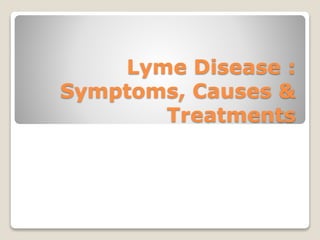
Lyme Disease
- 1. Lyme Disease : Symptoms, Causes & Treatments
- 2. What Is Lyme Disease? Lyme disease is an infection that is transmitted through the bite of a tick infected with a bacterium called Borrelia burgdorferi. Ticks typically get the bacterium by biting infected animals, like deer and mice. Most people who get tick bites do not get Lyme disease. Not all ticks are infected, and the risk for contracting the disease increases the longer the tick is attached to the body.
- 3. Symptoms: Early Stage Within one to four weeks of being bitten by an infected tick, most people will experience some symptoms of Lyme disease. A circular, expanding rash (called erythema migrans) at the site of the bite develops in about 70%-80% of cases. Some people report flu-like symptoms at this stage, including fever, chills, headaches, fatigue, swollen lymph nodes, joint pain, and muscle aches.
- 4. Symptoms: As the Infection Spreads If the disease is not detected and treated in its early stages, it can extend to more areas of the body, affecting the joints, heart, and nervous system (after several weeks to months after the initial bite). Additional rashes may occur, and there may be intermittent periods of pain and weakness in the arms or legs. Facial-muscle paralysis (Bell's palsy), headaches, and poor memory are other symptoms at this stage, along with a rapid heartbeat and some loss of control of facial muscles.
- 6. Symptoms: Late-Stage Disease This is the most serious stage of the disease, when treatment was either not successful or never started (usually occurring many months after the initial bite). Joint inflammation (arthritis), typically in the knees, becomes apparent, and may become chronic. The nervous system can develop abnormal sensation because of disease of peripheral nerves (peripheral neuropathy), and confusion. Heart problems are less common, but can include inflammation of the heart muscle and an irregular beat.
- 8. Do All Ticks Transmit Lyme Disease? No. In the northeastern and north-central U.S., the black-legged tick (or deer tick) transmits Lyme disease. In the Pacific coastal U.S., the disease is spread by the western black-legged tick. Other major tick species found in the U.S., including the lone star tick and the dog tick, have NOT been shown to transmit the Lyme disease bacterium. But beware: Lyme disease has been reported in all 50 states, as well as in Canada, Europe, Asia, Australia, and South America.
- 10. How Lyme Disease is NOT Spread You can't catch Lyme disease by being around an infected person. And although pets can become infected by a tick, they cannot transmit the disease to humans unless an infected tick falls off the animal and then bites a person. Insects such as mosquitoes, flies, or fleas cannot spread the disease to humans either. Only infected ticks have that honor.
- 11. Diagnosing Lyme Disease Doctors can diagnose the disease through physical findings such as a "bull's-eye" rash along with a history of symptoms. But not everyone has the rash, and not everyone can recall being bitten. Special blood tests can be taken three to four weeks after suspected contact to confirm the diagnosis. Other tests, such as a spinal tap or skin biopsy, may be done to help diagnose or rule out other conditions.
- 12. Treating Lyme Disease Most Lyme disease is curable with antibiotics, particularly when the infection is diagnosed and treated early. Later stages might require longer-term, intravenous antibiotics.
- 13. Is There a Lyme Disease Vaccine? Currently, there is no human vaccine for Lyme disease. A vaccine was developed years ago for use in high-risk areas, but it is no longer available. Illustrated here: Borrelia burgdorferi bacterium.
- 14. Preventing Lyme Disease Avoid tick bites whenever possible by staying clear of grassy or wooded areas, especially May to July. Cover your body head-to-toe when entering possible tick-infested areas. Apply an insect repellent containing DEET directly to your skin. Insect repellents containing permethrin can be applied to clothes to kill ticks on contact, but never apply to the skin. When coming in from outdoors inspect your body thoroughly for ticks; do the same for pets. Wash your skin and scalp to knock off any ticks that are only loosely attached.
- 15. How to Remove a Tick If you have a tick, it is important to remove it properly. Using fine-tipped tweezers, grasp the part of the tick that's closest to your skin -- you want to grab the head, not the belly. Slowly pull the tick straight out, without twisting it. Wash the bite site with soap and warm water. Throw the dead tick into the trash. Do not use a lit match, nail polish, petroleum jelly, or other topical agents in an attempt to remove a tick.